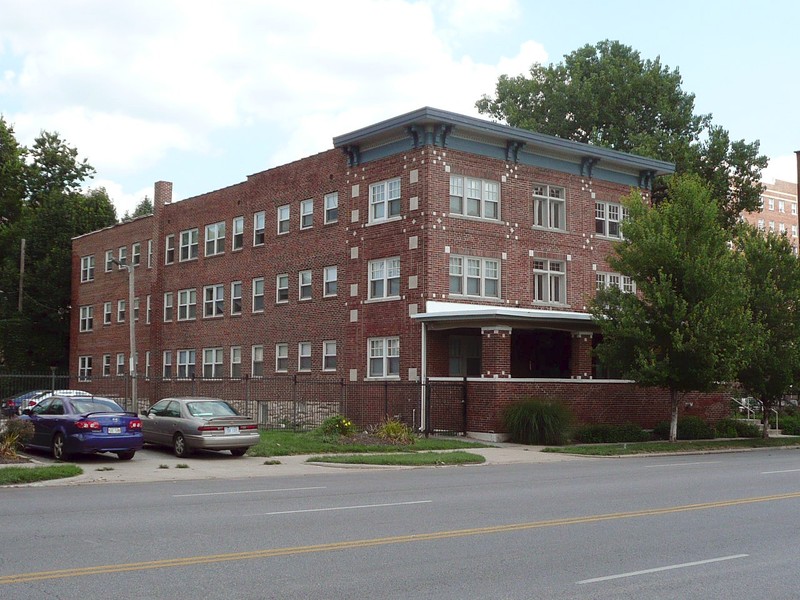Gillham Court Apartments Building
Introduction
Text-to-speech Audio
Construction on the Gillham Court Apartments Building was completed in 1925, a time when numerous apartment buildings in this area were designed to meet the budget and housing needs of an increasing working- and middle-class population of the city as it grew rapidly in the early twentieth century. The Gillham arose two years after the Windsor Hall Apartment Building was built, which is adjacent to the Gillham and enjoys almost an identical design. In the 1920s, the Hyde Park area of Kansas City was in a period of transition from a place reserved for the affluent to a mixture of middle-class wage earners. Apartments building like this were part of that transition. The Gillham Court Apartments Building was similar to other "walk up" apartments that were constructed in the area at this time. Unlike luxury hotel-apartment buildings nearby, Gillham had no formal entrance lobby and no amenities were offered to residents. Nevertheless, the well-constructed units were located along a streetcar line and offered comfortable and fairly spacious living for middle and working class residents.
Images
Gillham Court Apartments Building

Backstory and Context
Text-to-speech Audio
The Gillham Court Apartments Building existed as one of three identical "walk-up'- apartment buildings built in Kansas City by real estate developer Harry E. Fisher. The apartments arose during Kansas City's post-World War I apartment building boom in Kansas City and, more specifically, during the city's most prolific period of apartment construction leading up to the end of World War II. Deemed as Low-Rise Walk-Up Apartment Buildings, they usually lacked ornate designs or amenities included in apartments and hotel apartments designed for the upper and upper-middle classes. Each building measured approximately 39 feet by 105 feet and provided about two dozen small, self-sufficient apartment units for working- and middle-class occupants. The buildings' locations, directly adjacent to the busy Gillham Road streetcar line on Gillham Road, allowed easy access to shopping districts and places of employment.
The rise in apartment buildings speaks to the changing nature of the neighborhood. Large homes and grand mansions emerged in the Hyde Park (and vicinity) area by the late nineteenth century, followed by several hotel-apartment buildings in the early twentieth century that catered to the upper/middle class and wealthy. Commonly, Low-Rise Walk-Up Apartment Buildings from the 1920s through the 1950s featured working-class (or lower/middle class) tenants such as single men or women, married couples, and widows. The men regularly worked in such occupations as clerks or salesmen, while the single women often worked as nurses or stenographers. Most residents stayed in the apartments short-term. After World War II, the transition and evolution continued as lower-class residents moved into the Windsor Hall and Gillham Court Apartments; vacancy rates also rose substantially.
Though the area generally declined through the 1970s, the neighborhood enjoyed a slow rebound by the 1990s. Today's Hyde Park and vicinity area offer residents views of the neighborhood's 1880s-1920s past and has an influx of newer residents. The Gillham Apartments continue to function as an apartment building, serving many of those newer residents.
Cite This Entry
Admin, Clio and Mathew Powers. "Gillham Court Apartments Building." Clio: Your Guide to History. August 20, 2021. Accessed March 26, 2025. https://theclio.com/tour/2016/10
Sources
Doeden, Mary. "Nomination Form: Gillham Court Apartments Building." National Register of Historic Places. mostateparks.com. 2007. https://mostateparks.com/sites/mostateparks/files/Gilham%20Court%20Apts.%20Bldg.pdf.
"Gillham House - Kansas City Apartments." Mac Properties. macapartments.com. Accessed August 19, 2021. https://www.macapartments.com/property/Gillham-House
Hyde Park Neighborhood Association. "About Hyde Park: Kansas City's Historic Hyde Park." hydeparkkc.org. Accessed August 19, 2021. https://hydeparkkc.org/about-hyde-park/.
Powers, Mathew. "Windsor Hall Apartments." Clio: Your Guide to History. August 20, 2021. https://www.theclio.com/entry/139208
By Mwkruse - Own work, CC BY-SA 3.0, https://commons.wikimedia.org/w/index.php?curid=42446361

